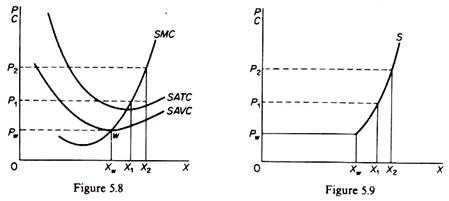This article will help you to learn about the difference between supply curve of a firm and industry.
Difference between Supply Curve of a Firm and Industry
The supply curve of the firm may be derived by the points of intersection of its MC curve with successive demand curves.
Assume that the market price increases gradually. This causes an upward shift of the demand curve of the firm. Given the positive slope of the MC curve, each higher demand curve cuts the (given) MC curve to a point which lies to the right of the previous intersection.
This implies that the quantity supplied by the firm increases as price rises.
ADVERTISEMENTS:
The firm, given its cost structure, will not supply any quantity (will close down) if the price falls below Pw, because at a lower price the firm does not cover its variable costs (figure 5.8). If we plot the successive points of intersection of MC and the demand curves on a separate graph we observe that the supply curve of the individual firm is identical to its MC curve to the right of the closing-down point w. Below Pw the quantity supplied by the firm is zero. As price rises above Pw the quantity supplied increases. The supply curve of the firm is shown in figure 5.9.
The industry-supply curve is the horizontal summation of the supply curves of the individual firms. It is assumed that the factor prices and the technology are given and that the number of firms is very large. Under these conditions the total quantity supplied in the market at each price is the sum of the quantities supplied by all firms at that price.
In figure 5.10 we show the industry supply as a straight line with a positive slope. It should, however, be noted that the particular shape of the market-supply curve depends on the technology and on factor prices, as well as the size distribution of the firms in the industry. All firms are not usually of the same size. The particular size of each firm in perfect competition depends on the entrepreneurial efficiency of the businessman, which is traditionally considered as a random attribute.

